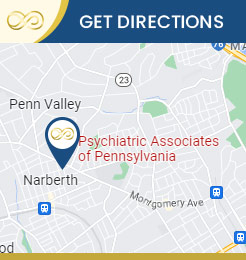Sleep Disorder Specialists on the Main Line of Philadelphia, in Narberth PA
Are you curious about: Why can’t I sleeping? Why am I always tired? How can I get better sleep? What are different kinds of sleep disorders? Can medications help me sleep? Why is sleep important? Our sleep experts are here to help. Contact us for more information or schedule an appointment online. We are conveniently located on the Main Line of Philadelphia, serving patients from Narberth PA, Philadelphia PA, Plymouth Meeting PA, Ardmore PA, Villanova PA, Media PA, Wayne PA, Malvern PA, King of Prussia PA, Newtown Square PA, Abington PA, and surrounding areas.


Table of Contents:
What are Sleep Disorders?
What are symptoms of Sleep Disorders?
How are Sleep Disorders diagnosed?
What cause Sleep Disorders?
How are Sleep Disorders treated?
Sleep disorders are a group of conditions that affect the quality, timing, and duration of sleep. They can disrupt a person’s ability to fall asleep, stay asleep, or achieve restful sleep, resulting in various physical, mental, and emotional symptoms. Sleep disorders can significantly impact overall health, daily functioning, and well-being.
There are numerous types of sleep disorders, including:
Insomnia: Difficulty falling asleep or staying asleep, leading to inadequate sleep duration and poor sleep quality. It can be caused by stress, anxiety, medical conditions, or certain medications.
Sleep Apnea: A disorder characterized by pauses in breathing or shallow breaths during sleep, often accompanied by loud snoring. These interruptions in breathing can briefly awaken a person, leading to fragmented sleep and excessive daytime sleepiness.
Narcolepsy: A neurological disorder that affects the brain’s ability to regulate sleep-wake cycles. It causes excessive daytime sleepiness, sudden episodes of sleep, and a loss of muscle control (cataplexy) triggered by strong emotions.
Restless Legs Syndrome (RLS): An uncomfortable sensation in the legs, typically occurring in the evening or at night, which leads to an irresistible urge to move the legs. RLS can disrupt sleep and cause sleep deprivation.
Circadian Rhythm Disorders: Conditions that result from a misalignment between a person’s internal body clock and the external environment. Examples include jet lag, shift work disorder, and delayed sleep phase syndrome (when a person’s sleep-wake cycle is significantly delayed compared to the desired schedule).
Parasomnias: Abnormal behaviors or experiences that occur during sleep or during the transition to or from sleep. Examples include sleepwalking, sleep talking, night terrors, and REM sleep behavior disorder (acting out dreams).
Sleep-related movement disorders: Conditions involving abnormal movements or behaviors during sleep. Restless leg syndrome (RLS) falls under this category, but other examples include periodic limb movement disorder (PLMD) and sleep-related bruxism (teeth grinding).
Sleep-related breathing disorders: Conditions that involve disruptions in breathing during sleep, such as obstructive sleep apnea (OSA), central sleep apnea (CSA), or sleep-related hypoventilation.
These are just a few examples of sleep disorders. It’s important to note that many sleep disorders can coexist or share similar symptoms, and a proper diagnosis requires evaluation by a healthcare professional, usually a sleep specialist. Treatment options vary depending on the specific disorder and may involve lifestyle changes, medications, therapy, or the use of medical devices.
Sleep disorders can present a wide range of symptoms, and the specific symptoms experienced can vary depending on the type of sleep disorder. Here are some common symptoms associated with various sleep disorders:
Insomnia:
o Difficulty falling asleep at night
o Waking up frequently during the night
o Trouble returning to sleep after waking up in the middle of the night
o Feeling unrested or fatigued after sleep
o Daytime sleepiness
o Difficulty concentrating or focusing
o Irritability, mood swings, or anxiety
Sleep Apnea:
o Loud and chronic snoring
o Pauses in breathing during sleep, often witnessed by a bed partner
o Gasping or choking sensations during sleep
o Excessive daytime sleepiness
o Morning headaches
o Dry mouth or sore throat upon waking
o Difficulty staying asleep
o Poor concentration or memory problems
Narcolepsy:
o Excessive daytime sleepiness, regardless of adequate nighttime sleep
o Sudden and uncontrollable episodes of falling asleep during the day
o Brief loss of muscle control (cataplexy) triggered by strong emotions
o Sleep paralysis (temporary inability to move or speak upon waking up or falling asleep)
o Vivid dream-like hallucinations when falling asleep or waking up
Restless Legs Syndrome (RLS):
o Uncomfortable sensations in the legs, often described as creeping, crawling, tingling, or itching
o Urge to move the legs to relieve discomfort, which is temporarily relieved by movement
o Worsening of symptoms during periods of rest or in the evening or nighttime
o Disrupted sleep due to leg discomfort and constant movement
Circadian Rhythm Disorders:
o Difficulty falling asleep at the desired time
o Trouble waking up at the desired time
o Irregular sleep patterns
o Daytime sleepiness or fatigue
o Difficulty adjusting to shift work schedules or time zone changes
Parasomnias:
o Sleepwalking (getting out of bed and walking around during sleep)
o Sleep talking
o Nightmares or night terrors (sudden waking with intense fear or distress)
o Acting out dreams (punching, kicking, or shouting during sleep)
o Teeth grinding (bruxism)
o Bedwetting (enuresis) in adults
Sleep-related movement disorders:
o Repetitive leg movements during sleep (periodic limb movement disorder)
o Jerking or flailing movements during sleep
o Involuntary teeth grinding (bruxism)
o Restless movements or fidgeting during sleep
These are some common symptoms associated with sleep disorders, but it’s important to remember that the symptoms can vary in severity and frequency among individuals. If you suspect you have a sleep disorder, it is advisable to consult with a healthcare professional for an accurate diagnosis and appropriate treatment.
The diagnosis of sleep disorders typically involves a comprehensive evaluation that may include the following steps:
Medical History: Your healthcare provider will start by taking a detailed medical history, including questions about your sleep patterns, sleep-related symptoms, and overall health. They may inquire about your sleep schedule, bedtime routines, snoring, breathing difficulties, daytime sleepiness, and any other relevant symptoms.
Sleep Diary: Keeping a sleep diary for a week or two can provide valuable information about your sleep patterns and habits. You’ll record the time you go to bed, wake up, and any notable events during the night, such as awakenings or difficulties falling asleep.
Physical Examination: A physical examination may be conducted to assess any physical factors that could contribute to sleep disorders. For example, the examination may focus on the respiratory system, checking for signs of nasal congestion, tonsillar enlargement, or obesity.
Sleep Questionnaires and Screening Tools: Your healthcare provider may ask you to complete questionnaires or screening tools designed to assess your sleep quality, daytime sleepiness, and the presence of specific sleep disorders. These tools can help identify potential sleep disorders and provide additional information for diagnosis.
Sleep Study (Polysomnography): Polysomnography is a comprehensive sleep study that involves monitoring various physiological parameters during sleep. It is often conducted in a sleep lab or, in some cases, at home using portable devices. During the study, electrodes are placed on your scalp, face, chest, and legs to record brain activity, eye movements, muscle activity, heart rate, breathing patterns, and oxygen levels. This test helps diagnose sleep apnea, narcolepsy, periodic limb movement disorder, and other sleep disorders.
Additional Sleep Tests: Depending on the suspected sleep disorder, additional tests may be recommended. These may include multiple sleep latency test (MSLT) to assess daytime sleepiness and REM sleep behavior disorder (RBD) testing, among others.
Consultation with a Sleep Specialist: In complex cases or when a specific sleep disorder is suspected, you may be referred to a sleep specialist a physician with expertise in sleep medicine. They will review the gathered information, conduct further assessments if necessary, and provide a definitive diagnosis.
The diagnostic process may vary depending on the specific sleep disorder being evaluated. It’s important to work closely with a healthcare professional who specializes in sleep medicine to ensure an accurate diagnosis and appropriate treatment plan.
Sleep disorders can have various causes, and they can be influenced by a combination of factors, including physiological, psychological, and environmental factors. Here are some common causes and contributing factors to sleep disorders:
Disruptions in the Sleep-Wake Cycle: Irregular sleep schedules, frequent shift work, or crossing time zones can disrupt the body’s natural circadian rhythm, leading to sleep disorders like jet lag or shift work sleep disorder.
Medical Conditions and Chronic Illnesses: Certain medical conditions can interfere with sleep, such as sleep apnea, chronic pain conditions, respiratory disorders, neurological disorders (e.g., Parkinson’s disease, Alzheimer’s disease), gastrointestinal disorders (e.g., acid reflux), and hormonal disorders (e.g., thyroid disorders).
Psychological and Emotional Factors: Stress, anxiety, depression, and other mental health conditions can disrupt sleep patterns and contribute to insomnia or hypersomnia (excessive sleepiness).
Medications and Substances: Some medications, including antidepressants, corticosteroids, and certain allergy or cold medications, can interfere with sleep. Additionally, substances such as caffeine, nicotine, and alcohol can disrupt sleep quality and make it harder to fall asleep or stay asleep.
Sleep-Disordered Breathing: Conditions like obstructive sleep apnea, where the airway becomes partially or completely blocked during sleep, can lead to frequent awakenings and disrupted sleep.
Genetics and Family History: Some sleep disorders, such as narcolepsy and certain types of insomnia, can have a genetic component and run in families.
Lifestyle Factors: Unhealthy sleep habits, such as irregular sleep schedules, excessive daytime napping, exposure to bright screens before bedtime, and an uncomfortable sleep environment, can contribute to sleep disturbances.
Age-related Changes: Sleep patterns and needs change throughout life. Infants and young children may experience sleep problems related to developmental stages, while older adults may have increased risk for conditions like insomnia and sleep apnea.
Other Factors: Certain factors like obesity, hormonal changes (e.g., menopause), sleep-related movement disorders (e.g., restless legs syndrome), and environmental factors (e.g., noise, light pollution) can also contribute to sleep disorders.
It’s important to note that the causes of sleep disorders can be complex and interconnected, and it may require a comprehensive evaluation by a healthcare professional, such as a sleep specialist, to determine the underlying causes and develop an appropriate treatment plan.
The treatment of sleep disorders depends on the specific type of sleep disorder and its underlying causes. It’s essential to consult with a healthcare professional, preferably a sleep specialist, who can evaluate your condition and recommend an appropriate treatment plan. Here are some common approaches to treating sleep disorders:
Lifestyle and Behavioral Modifications: Making certain changes to sleep habits and behaviors can significantly improve sleep quality. These may include:
o Establishing a consistent sleep schedule: Going to bed and waking up at the same time every day, even on weekends.
o Creating a relaxing bedtime routine: Engaging in calming activities before bed, such as reading, taking a warm bath, or practicing relaxation techniques.
o Promoting a sleep-friendly environment: Ensuring the sleep environment is comfortable, quiet, dark, and cool.
o Limiting exposure to electronic devices: Avoiding screens (e.g., smartphones, tablets, computers) before bedtime, as the blue light can interfere with sleep.
o Avoiding stimulants and substances: Minimizing or avoiding caffeine, nicotine, alcohol, and heavy meals close to bedtime.
o Regular physical activity: Engaging in regular exercise during the day, but avoiding vigorous exercise close to bedtime.
Cognitive Behavioral Therapy for Insomnia (CBT-I): CBT-I is a structured therapy that targets the thoughts, behaviors, and environmental factors affecting sleep. It helps identify and modify negative thoughts or anxieties about sleep, establishes healthy sleep habits, and addresses underlying factors contributing to insomnia.
Medications: In some cases, medications may be prescribed to manage sleep disorders. This is typically done under the guidance of a healthcare professional, and the choice of medication depends on the specific sleep disorder. For example:
o Insomnia: Sleep aids or sedative medications may be prescribed for short-term use to help initiate or maintain sleep. Non-benzodiazepine hypnotics, such as zolpidem or eszopiclone, or low-dose sedating antidepressants, like trazodone or Remeron, may be prescribed.
o Sleep apnea: Continuous positive airway pressure (CPAP) therapy is the most common treatment for obstructive sleep apnea. It involves wearing a mask over the nose or nose and mouth during sleep, which delivers pressurized air to keep the airway open. Other devices such as Mandibular Advancement Devices can be used as well. Under certain circumstances, surgery may also be an option.
o Narcolepsy: Stimulant medications, such as modafinil or methylphenidate, are often prescribed to promote wakefulness during the day. Medications to manage cataplexy and other symptoms may also be recommended.
Medical Interventions and Devices: For certain sleep disorders, medical interventions or devices may be used. For example:
o Sleep apnea: Besides CPAP, other treatments like oral appliances that help keep the airway open or surgery to address anatomical abnormalities may be considered.
o Restless Legs Syndrome (RLS): Medications like dopamine agonists or anti-seizure medications can help manage RLS symptoms.
o Circadian rhythm disorders: Light therapy, where exposure to bright light is used to shift or regulate the sleep-wake cycle, may be recommended.
Treatment of Underlying Medical Conditions: When sleep disorders are secondary to underlying medical conditions (e.g., depression, anxiety, chronic pain), treating and managing the underlying condition may improve sleep.
It’s important to note that the treatment approach will be tailored to your specific needs and may involve a combination of these strategies. Regular follow-up with a healthcare professional is crucial to monitor progress, adjust treatments if necessary, and ensure optimal management of sleep disorders.


Additional Conditions We Treat
▸ Life Transitions
▸ Depression & Other Mood Disorders
▸ Anxiety Disorders
▸ PTSD & Other Trauma Related Disorders
▸ Obsessive Compulsive Disorders
▸ Attention Deficit and Hyperactivity Disorder (ADHD)
▸ Bipolar Disorders
▸ Eating Disorders
▸ Autism Spectrum Disorders
▸ Psychotic Disorders
▸ Sleep Disorders
▸ Phobia Experts
▸ Gender Dysphoria
▸ LGBTQIA+ Affirmative Therapy
▸ Men’s Mental Health
▸ Women’s Issues
▸ End of Life Mental Health
Additional Services You May Need
▸ Psychiatry and Medication Management
▸ Child and Adolescent Psychiatry
▸ Therapy and Counseling
▸ Treatment Resistant Depression
▸ Treatment Resistant OCD
▸ Smoking Cessation
▸ Transcranial Magnetic Stimulation (TMS)
▸ Psychoeducational Assessments
▸ Eating Disorders Program
▸ Neurofeedback
▸ Neurotechnology
▸ Virtual Reality Exposure Therapy
▸ Genetic Counseling
▸ Preventative Mental Health
▸ Forensic Psychiatry
▸ Anger Management
▸ Cognitive Behavioral Therapy
▸ Couples Counseling
▸ EMDR
▸ Family Therapists
▸ Grief Counselors
▸ Mindfulness and Meditation
▸ Palliative Psychology
▸ Internal Family Systems
▸ Parenting Coach
▸ Executive Mental Health


